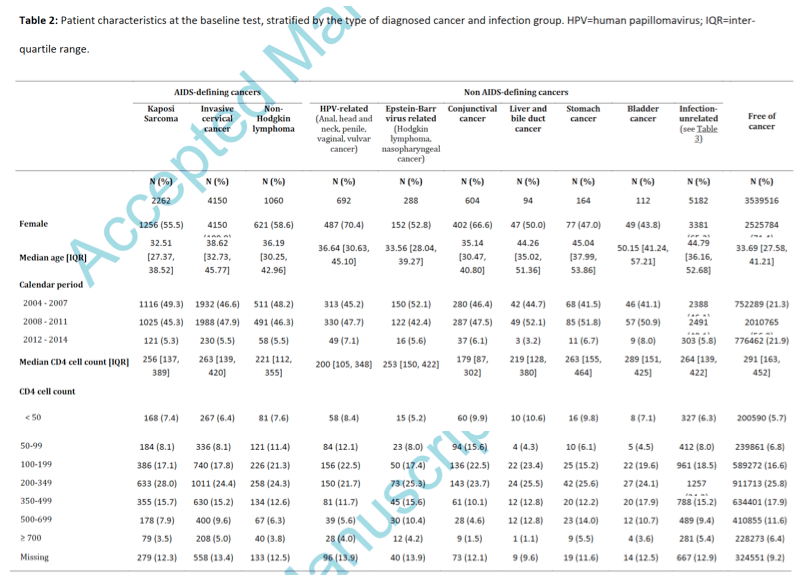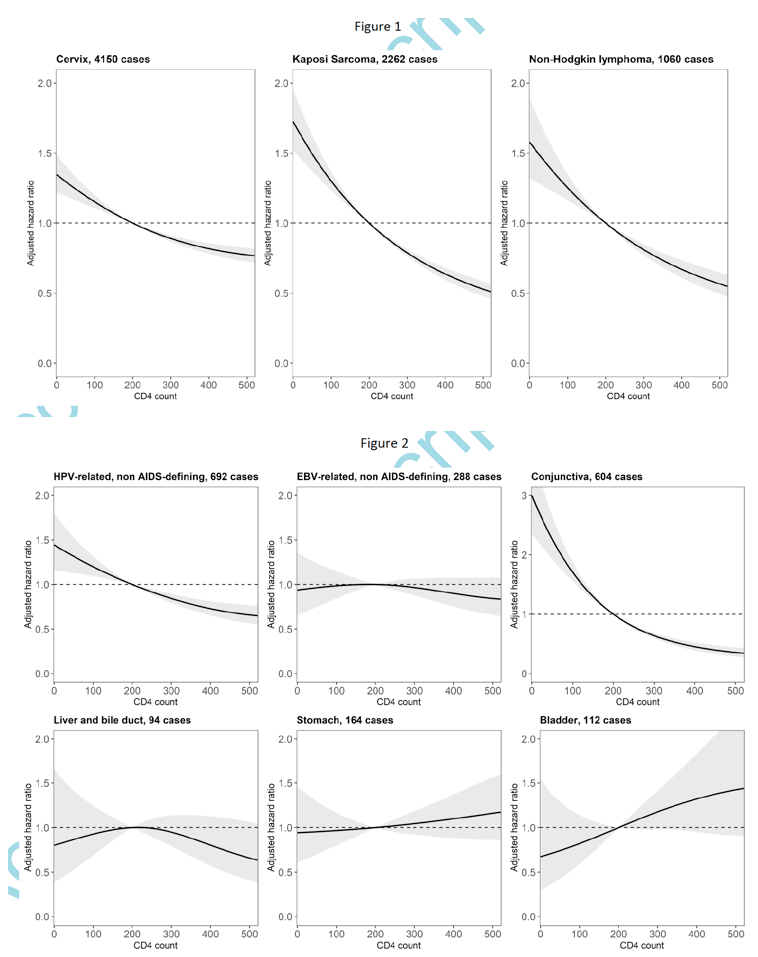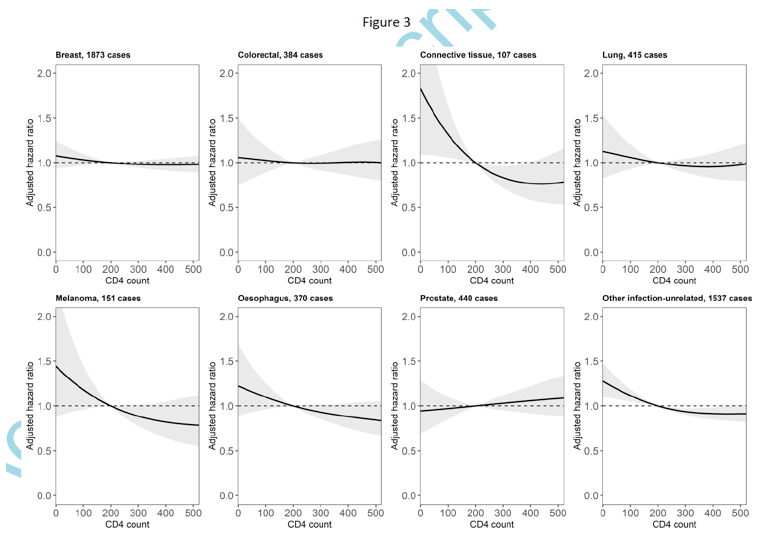| |
Immunodeficiency and Cancer in 3.5 Million People Living with Human Immunodeficiency Virus: the South African HIV Cancer Match Study
|
| |
| |
Download the PDF here
Clinical Infectious Diseases
02 February 2021
Advanced immunodeficiency is associated with an increased risk of developing AIDS-defining cancers and various non-AIDS-defining infection-related cancers among a nationwide cohort of PLWH in South Africa. The association between lower CD4 counts and higher cancer incidence rates was strong for conjunctival cancer, KS, NHL, cervical and other HPV-related cancers. We did not find an association between lower CD4 counts and higher rates of cancers related to non-viral infections, i.e. stomach (h.pylori) and bladder cancer (schistosomiasis), and common infection-unrelated cancers including breast, lung, and prostate cancer. The association between lower CD4 counts and cancer incidence tended to be stronger in women than men for KS and NHL.

Immunodeficiency and Cancer in 3.5 Million People Living with Human Immunodeficiency Virus: the South African HIV Cancer Match Study
Clinical Infectious Diseases
02 February 2021
Abstract
Background
We analysed associations between immunodeficiency and cancer incidence in a nationwide cohort of people living with the human immunodeficiency virus (HIV) in South Africa.
Methods
We used data from the South African HIV Cancer Match study built on HIV-related laboratory measurements from the National Health Laboratory Services and cancer records from the National Cancer Registry. We evaluated associations between time-updated CD4 cell count and cancer incidence rates using Cox proportional hazards models. We reported adjusted hazard ratios (aHR) over a grid of CD4 values and estimated the aHR per 100 CD4 cells/µl decrease.
Results
Of 3,532,266 people living with HIV (PLWH), 15,078 developed cancer. The most common cancers were cervical cancer (4,150 cases), Kaposi sarcoma (2,262 cases), and non-Hodgkin lymphoma (1,060 cases). The association between lower CD4 cell count and higher cancer incidence rates was strongest for conjunctival cancer (aHR per 100 CD4 cells/µl decrease: 1.46, 95% confidence interval [CI] 1.38-1.54), Kaposi sarcoma (aHR 1.23, 95% CI 1.20-1.26), and non-Hodgkin lymphoma (aHR 1.18, 95% CI 1.14-1.22). Among infection-unrelated cancers, lower CD4 cell counts were associated with higher incidence rates of oesophageal cancer (aHR 1.06, 95 CI 1.00-1.11), but not breast, lung, or prostate cancer.
Conclusions
Lower CD4 cell counts were associated with an increased risk of developing various infection-related cancers among PLWH. Reducing HIV-induced immunodeficiency may be a potent cancer prevention strategy among PLWH in sub-Saharan Africa, a region heavily burdened by cancers attributable to infections.
Results
Cancer cases and patient characteristics
The SAM cohort provided data on 13,608,064 PLWH, of which 3,532,266 were included in the overall cancer analysis (Supplementary Figure 1). A total of 27,954 adults were excluded from the analysis due to a prevalent cancer diagnosis (Supplementary Table 1). Among the included PLWH, 15,078 developed incident cancer over 9,108,565 person-years. The median time-at-risk was 2.1 years (inter-quartile range [IQR] 0.9-3.6) and the median number of CD4 measurements was 3 (IQR 2-5). Among infection-related cancers, the most common types were cervical cancer (4,150 cases), KS (1,262 cases), and NHL (1,060 cases). Non-AIDS-defining infection-related cancers were less common: there were 692 cases of non-AIDS-defining HPV-related cancers, 604 cases of conjunctival cancers, 288 cases of non-AIDS-defining EBV-related cancers, 164 cases of stomach cancers, 122 cases of bladder cancers, and 94 cases of liver and bile duct cancer.
There were 5,182 patients diagnosed with an infection-unrelated cancer. The most common infection-unrelated cancer was breast cancer (1,873 cases). There were 440 men diagnosed with prostate cancer. Lung cancer (415 cases), colorectal cancer (384 cases), oesophageal cancer (370 cases), melanoma of the skin (151 cases), and connective and soft tissue tumours (107 cases) were less common. Excluding these seven cancer types, there were 1,537 patients diagnosed with other infection-unrelated cancers.
Table 2 and Table 3 show the baseline characteristics of included PLWH, stratified by cancer type. Less than a third of the total study population were male (28.6%). Still, most patients with stomach, bladder, lung, and oesophageal cancer were male. The baseline median age was generally higher among PLWH with cancer compared to those remaining free of cancer. It ranged from 32.5 years for KS to 55.6 years for prostate cancer, compared to 33.7 years in PLWH without cancer. The median CD4 count at baseline was lower in PLWH who developed cancer than those who did not. It ranged from 179 cells/μL in PLWH with conjunctival cancer to 291 cells/μL in PLWH with breast cancer, compared to 292 cells/μL in PLWH free of cancer. A summary of age and calendar year at cancer diagnosis is shown in Supplementary Tables 2 and 3.
Immunodeficiency and cancer incidence
Across all cancers, the penalized spline approach yielded lower or similar AIC values compared to linear models, indicating better fit to the data (Supplementary Table 4). Thus, we chose this approach for our primary analysis.
From visual inspection of results, lower CD4 counts were associated with higher incidence rates of the three AIDS-defining cancers (Figure 1), the non-AIDS-defining HPV-related cancers, and conjunctival cancer (Figure 2), but not with higher rates of liver, stomach, or bladder cancer. There was no evidence of an association between lower CD4 counts and higher incidence of non-AIDS-defining EBV-related cancers (Hodgkin lymphoma and nasopharyngeal cancer). Among infection-unrelated cancers, we found an association between lower CD4 counts and higher incidence of connective and soft tissue cancer (Figure 3). There was also limited evidence of an association with oesophageal cancer and melanoma of the skin.


When assuming a linear relationship between CD4 count and the log-hazard, we found that among infection-related cancers, the association with CD4 count (aHR per 100 CD4 cells/μL decrease) was strongest for conjunctival cancer, followed by KS and NHL (Figure 4). Moreover, there was evidence for a weak protective effect of a lower CD4 count against stomach cancer (aHR per 100 CD4 cells/μL decrease 0.92, 95% CI 0.87-0.98). Among infection-unrelated cancers, the association between a lower CD4 count and cancer incidence was strongest for melanoma of the skin and oesophageal cancer. Sex modified the association between CD4 count and cancer incidence for NHL (p=0.006) and KS (p=0.005), with the association being more substantial in women than men (Supplementary Figure 2).
Discussion
Advanced immunodeficiency is associated with an increased risk of developing AIDS-defining cancers and various non-AIDS-defining infection-related cancers among a nationwide cohort of PLWH in South Africa. The association between lower CD4 counts and higher cancer incidence rates was strong for conjunctival cancer, KS, NHL, cervical and other HPV-related cancers. We did not find an association between lower CD4 counts and higher rates of cancers related to non-viral infections, i.e. stomach (h.pylori) and bladder cancer (schistosomiasis), and common infection-unrelated cancers including breast, lung, and prostate cancer. The association between lower CD4 counts and cancer incidence tended to be stronger in women than men for KS and NHL.
Since the start of the HIV epidemic, many studies have explored the relationship between immunodeficiency and the incidence of infection-related cancers. In line with these, we found a clear association between lower CD4 counts and increased rates of AIDS-defining cancers, i.e., KS [10,11,17,18], NHL [10,11,19,20], and cervical cancer [10,21]. We and others [10,11,22,23] also observed higher incidence rates of non-AIDS-defining HPV-related cancers such as anal [10,22], vaginal/vulvar [24], and head and neck squamous cell carcinoma [23] at lower CD4 counts. In our study, we assessed time-updated CD4 counts lagged by one year, whereas others identified nadir and cumulative CD4 count as well as CD4 count lagged by several years to be stronger predictors for the risk of developing HPV-related cancers [10,22,23]. Immunodeficiency may promote HPV-related carcinogenesis early on by increasing the risk of HPV acquisition and reducing HPV clearance [25]. Our findings only partially confirm an increased liver cancer risk in PLWH with advanced immunodeficiency [10,11,26]. Conjunctival cancer is particularly common in Africa and has been linked to ultraviolet radiation and HIV infection [9]. Our results corroborate an important role of immunodeficiency in the development of this cancer. Studies from the US and Europe identified a clear association between lower recent CD4 counts and high Hodgkin’s lymphoma incidence rates [10,11,27]. However, we did not find such a trend for EBV-related non-AIDS-defining cancers (Hodgkin’s lymphoma and nasopharyngeal cancer).
Misdiagnosis of HIV-associated lymphomas as tuberculosis (TB) is common in resource-limited settings with high TB prevalence [28], and this may have distorted the estimated association between immunodeficiency and Hodgkin’s lymphoma risk. Of note, the association between CD4 counts and NHL risk in our study was also weaker than what has been described for North America and Europe [10,11,19]. Literature on the link between immunodeficiency and the risk of bladder and stomach cancers is scarce. An American study found a higher risk of developing non-cardia stomach cancer among PLWH with nadir CD4 counts ≤200 versus >200 cells/μl [29]. We did not find an association between lower CD4 counts and either bladder or stomach cancer incidence.
The association of lower CD4 counts with a KS and NHL risk was stronger among women than men. Most studies to date have not assessed whether the association between immunodeficiency and cancer risk is modified by sex. However, sex differences in cancer susceptibility have been reported consistently with most cancers occurring more frequently in men [30]. Sex differences in immune surveillance, with women generally mounting stronger immune responses, may contribute to differences in cancer susceptibility between male and female PLWH [31].
Few studies have assessed the association between HIV-induced immunodeficiency and infection-unrelated cancers, and data from Africa are generally not available. In the US, both breast and prostate cancer occur less frequently among PLWH than in the general population [32,33], with prostate cancer risk being reduced among men with lower CD4 counts at AIDS diagnosis [34]. However, we did not find an association between lower CD4 counts and either prostate or breast cancer incidence. In our study, there was some evidence for higher incidence rates at lower CD4 counts for oesophageal cancer as well as connective and soft tissue tumours. One study also found a higher risk of oesophageal squamous cell carcinoma among PLWH with lower nadir CD4, but the uncertainty was considerable [29]. The association between lower CD4 counts and the risk of connective and soft tissue tumours is in line with case reports suggesting an etiological role of EBV in the development of leiomyosarcomas and leiomyomas [35]. However, it could also be a spurious finding if some KS cases were misclassified as other soft tissue sarcomas. For malignant melanoma of the skin, we found a weak association with lower CD4 counts, but previous studies showed conflicting results [11,36]. The observation that some cancers currently categorized as infection-unrelated showed an association with lower CD4 counts could indicate that an unknown infectious cause may contribute to the development of these cancers.
This is the first large-scale study to explore associations between lower CD4 cell counts and various cancer types in sub-Saharan Africa. Our analysis included CD4 trajectories of 3.5 million PLWH over 9 million person-years. Our study has several limitations. Given that our cohort study was based on routine data, CD4 cell count measurements did not necessarily occur at regular intervals, and we did not have access to ART data. However, we adjusted for calendar period, with breakpoints chosen to match changes in South African ART guidelines. Information on cancer risk factors such as co-infections with other oncogenic viruses, lifestyle factors, or socioeconomic status was also unavailable. The database closing date was January 1st, 2015, but we do not expect immunodeficiency to influence cancer risk differently over time. The SAM study did not include mortality or emigration data. Thus, we censored patients six months after the last laboratory measurement. While this limits the amount of follow-up data in our study, we do not expect it to have biased our results. CD4 count is a commonly-studied biomarker. Still, CD8 count, CD4/CD8 ratio, or RNA viral load are also important biomarkers for some cancers [10,37,38]. The NHLS does not routinely assess CD8 counts, and RNA viral loads were not reported frequently enough to create reliable trajectories.
Close to 30% of cancers in sub-Saharan Africa are infection-related [15]. Among PLWH the proportion of cancers attributable to infections is particularly high, with a proportion of 40% estimated in the US [8]. In sub-Saharan Africa, the proportion of infection-related cancers among PLWH is likely to be even higher. Reducing immunodeficiency through early detection of HIV and effective ART has been key in decreasing KS and NHL incidence among PLWH worldwide [12,39], and evidence is accumulating that timely initiation of ART might reduce the risk of developing cervical and anal cancers [40,41]. However, it is less clear whether reducing HIV-induced immunodeficiency has a preventive effect on other cancers. We have shown that lower CD4 counts are associated with higher rates of various infection-related and infection-unrelated cancers among PLWH in South Africa. Therefore, preventing HIV-induced immunodeficiency may be an important strategy to reduce the disproportionate cancer burden among PLWH in sub-Saharan Africa. As the effect of immunodeficiency on carcinogenesis varies by cancer types, in-depth cancer-specific analyses are required. The SAM study, with its nationwide cohort of PLWH, provides an ideal platform for such analyses.
In conclusion, lower CD4 counts are associated with an increased risk of developing various infection-related cancers among PLWH. Reducing HIV-induced immunodeficiency may be a potent cancer prevention strategy among PLWH in sub-Saharan Africa, a region heavily burdened by cancers attributable to infections.
|
|
| |
| |
|
|
|